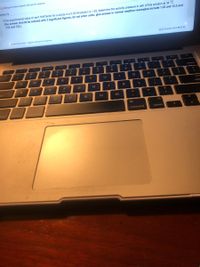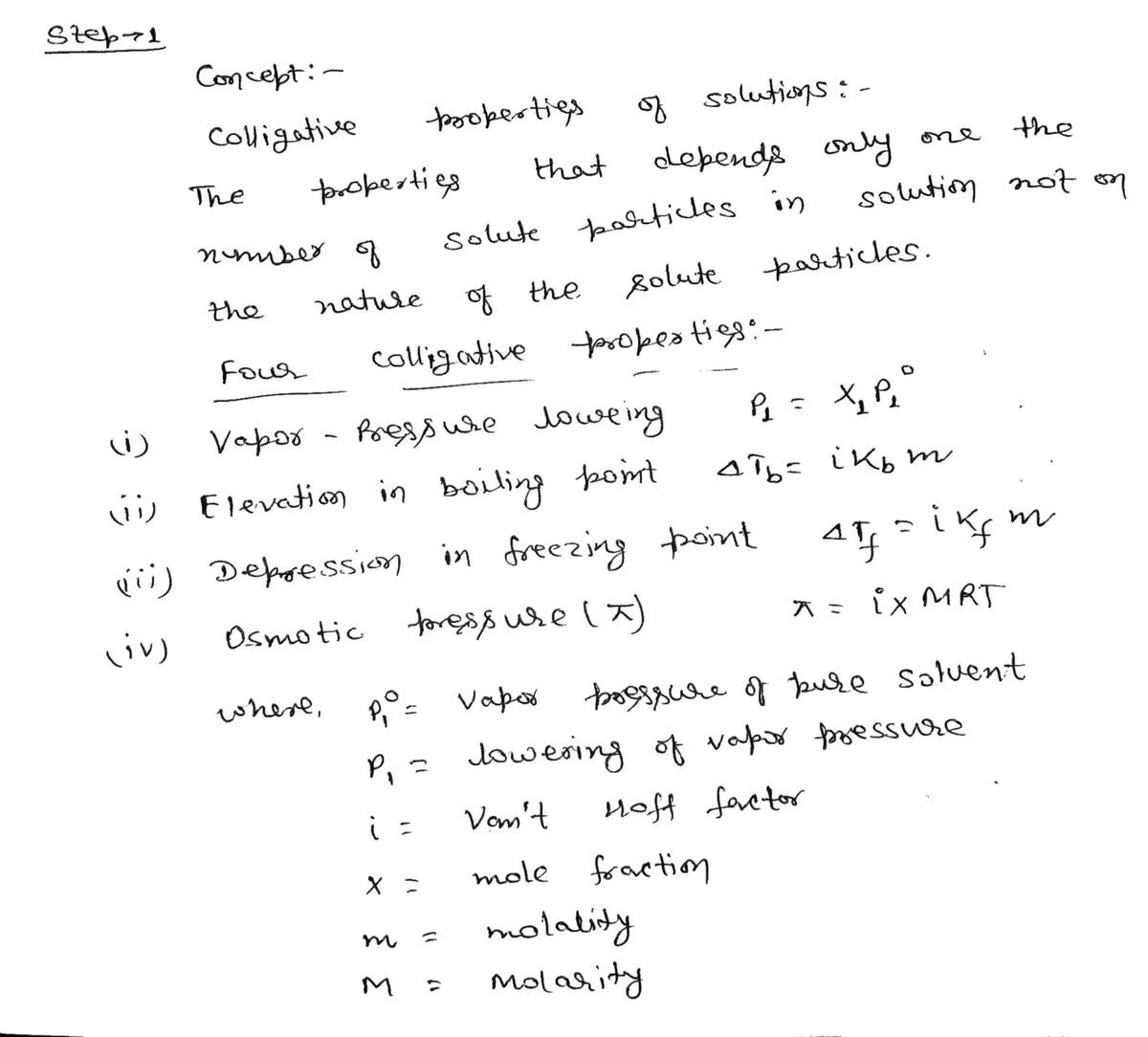
Chemistry
10th Edition
ISBN: 9781305957404
Author: Steven S. Zumdahl, Susan A. Zumdahl, Donald J. DeCoste
Publisher: Cengage Learning
expand_more
expand_more
format_list_bulleted
Concept explainers
Question

Transcribed Image Text:A Moving to another question will save this response.
pestion 12
If the experimental value of van't Hoff factor for a solute in a 0.30 M solution is 1.53, determine the osmotic pressure in atm of this solution at 34 °C.
(the answer should be entered with 3 significant figures; do not enter units; give answer in normal notation--examples include 1.23 and 12.3 and
123 and 123.)
K Question 12 of 29
AMoving to another question will save this response
V00>
BBE
%23
24
4.
7.
delete
w
R
Y
P
ente
A
D
F
G
H
K
L
eck
retu
B
N
alt
atrol oplion ommand
command
option
Expert Solution
arrow_forward
Step 1

Step by stepSolved in 2 steps with 2 images

Follow-up Questions
Read through expert solutions to related follow-up questions below.
Follow-up Question
How did they get R?
Can I get a breakdown pls?
Solution
by Bartleby Expert
Follow-up Questions
Read through expert solutions to related follow-up questions below.
Follow-up Question
How did they get R?
Can I get a breakdown pls?
Solution
by Bartleby Expert
Knowledge Booster
Learn more about
Need a deep-dive on the concept behind this application? Look no further. Learn more about this topic, chemistry and related others by exploring similar questions and additional content below.Similar questions
- Using Zaitsev's rule, choose the most stable alkene among the following. Draw out the structures of each of the options then select the correct answer. Recall that Zaitsev's Rule is about alkene stability. The trend for this is similar to the trend for carbocation stability. Either more or fewer groups on the alkene (and the carbocation) make it more stable. This question is wanting you to remember if it's more or fewer. A) 1,2-dimethylcyclohexene B) 1,6-dimethylcyclohexene C) cis-3,4-dimethylcyclohexene D) They are all of equal stability according to Zaitsev's rule. Provide the major dehydration product of the following reaction. Recall which of the four substitution and elimination reactions a dehydration is. Before you do your S# or EF mechanism, remember what heteroatoms do in the presence of an acid (aka-the-OH is a bad leaving group, but protonating it might turn it into a good one). Don't forget to apply the concept from the previous question. OH Ht Aarrow_forward114. mg of an unknown protein are dissolved in enough solvent to make 5.00 mL of solution. The osmotic pressure of this solution is measured to be 0.0231 atm at 25.0 °C. Calculate the molar mass of the protein. Be sure your answer has the correct number of significant digits. molarrow_forward107. mg of an unknown protein are dissolved in enough solvent to make 5.00 mL of solution. The osmotic pressure of this solution is measured to be 0.0197 atm at 25.0 °C. Calculate the molar mass of the protein. Round your answer to 3 significant digits. mol Xarrow_forward
- Convert the following concentrations into the desired units. A solution of diethylether (C4H10O) in acetone (C3H6O) that has a mole fraction of 0.25 to molality.arrow_forwardAt what temperature (in °C) would a 0.00570 M solution of glucose in water exhibit an osmotic pressure of 0.150 atm?arrow_forwardA salt solution has an osmotic pressure of 17.0 atmospheres at 17°C. What is the freezing point of this solution? Freezing point = °Carrow_forward
- At what temperature (in °C) would a 0.00510 M solution of glucose in water exhibit an osmotic pressure of 0.150 atm?arrow_forward296. mg of an unknown protein are dissolved in enough solvent to make 5.00 mL of solution. The osmotic pressure of this solution is measured to be 0.0580 atm at 25.0 °C. Calculate the molar mass of the protein. Round your answer to 3 significant digits.arrow_forwardA solution contains 22.4 grams of glucose (C 5 H 12 O 6 ) dissolved in 0.500 L of water. What is the molality (m) of the solution? (Assume a density of 1.00g / m * L for water). NotePlease report your answer to 3 significant figures and include the abbreviated form of the unit.arrow_forward
arrow_back_ios
arrow_forward_ios
Recommended textbooks for you
 ChemistryChemistryISBN:9781305957404Author:Steven S. Zumdahl, Susan A. Zumdahl, Donald J. DeCostePublisher:Cengage Learning
ChemistryChemistryISBN:9781305957404Author:Steven S. Zumdahl, Susan A. Zumdahl, Donald J. DeCostePublisher:Cengage Learning ChemistryChemistryISBN:9781259911156Author:Raymond Chang Dr., Jason Overby ProfessorPublisher:McGraw-Hill Education
ChemistryChemistryISBN:9781259911156Author:Raymond Chang Dr., Jason Overby ProfessorPublisher:McGraw-Hill Education Principles of Instrumental AnalysisChemistryISBN:9781305577213Author:Douglas A. Skoog, F. James Holler, Stanley R. CrouchPublisher:Cengage Learning
Principles of Instrumental AnalysisChemistryISBN:9781305577213Author:Douglas A. Skoog, F. James Holler, Stanley R. CrouchPublisher:Cengage Learning Organic ChemistryChemistryISBN:9780078021558Author:Janice Gorzynski Smith Dr.Publisher:McGraw-Hill Education
Organic ChemistryChemistryISBN:9780078021558Author:Janice Gorzynski Smith Dr.Publisher:McGraw-Hill Education Chemistry: Principles and ReactionsChemistryISBN:9781305079373Author:William L. Masterton, Cecile N. HurleyPublisher:Cengage Learning
Chemistry: Principles and ReactionsChemistryISBN:9781305079373Author:William L. Masterton, Cecile N. HurleyPublisher:Cengage Learning Elementary Principles of Chemical Processes, Bind...ChemistryISBN:9781118431221Author:Richard M. Felder, Ronald W. Rousseau, Lisa G. BullardPublisher:WILEY
Elementary Principles of Chemical Processes, Bind...ChemistryISBN:9781118431221Author:Richard M. Felder, Ronald W. Rousseau, Lisa G. BullardPublisher:WILEY

Chemistry
Chemistry
ISBN:9781305957404
Author:Steven S. Zumdahl, Susan A. Zumdahl, Donald J. DeCoste
Publisher:Cengage Learning

Chemistry
Chemistry
ISBN:9781259911156
Author:Raymond Chang Dr., Jason Overby Professor
Publisher:McGraw-Hill Education

Principles of Instrumental Analysis
Chemistry
ISBN:9781305577213
Author:Douglas A. Skoog, F. James Holler, Stanley R. Crouch
Publisher:Cengage Learning

Organic Chemistry
Chemistry
ISBN:9780078021558
Author:Janice Gorzynski Smith Dr.
Publisher:McGraw-Hill Education

Chemistry: Principles and Reactions
Chemistry
ISBN:9781305079373
Author:William L. Masterton, Cecile N. Hurley
Publisher:Cengage Learning

Elementary Principles of Chemical Processes, Bind...
Chemistry
ISBN:9781118431221
Author:Richard M. Felder, Ronald W. Rousseau, Lisa G. Bullard
Publisher:WILEY